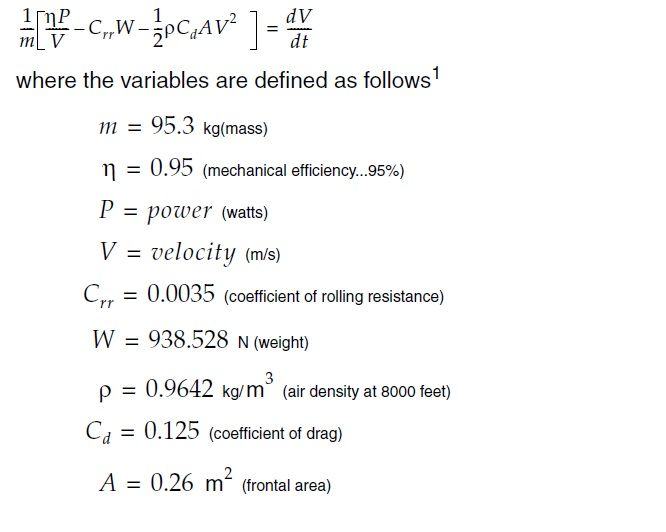
Maths help, rearanging a differential equation
tegwin - 11/2/13 at 04:36 PM
Ok... So Maths is really not my strong point which is causing me some grief here..
Are there any clever folk who could explain how to re-range this formula so that it becomes V=
I want to be able to put in all the variables and a value for time and get a velocity out.... I don't think it should be too hard but all the
constants are confusing the hell out of me!

renetom - 11/2/13 at 05:14 PM
V= the velocity at which you travel to the loony bin.
matt_claydon - 11/2/13 at 05:23 PM
Sorry, too long since I did that kind of thing to be able to actually solve it, but it's not simply a matter of rearranging; you will have to
rearrange then integrate to get rid of dv / dt, then work out the resulting constant based on some initial conditions. It doesn't look like
it'll be trivial to integrate! You could try plugging it into wolfram alpha and let the computer do the hard work.
tegwin - 11/2/13 at 05:26 PM
Matt.. I tried that to no avail sadly... 
Its safe to say that when T=0, V=0 so actually solving for the constant shouldnt be too tricky.
[Edited on 11/2/13 by tegwin]
morcus - 11/2/13 at 05:59 PM
The integral of that is cubic,
something along the lines of nP LnV - CrrWV - (1/6 x pCdAV^3) all divided by m and we have two unknowns.
However, if I'm reading this right, DV/Dt in this case is acceleration so you might be able to work it out that way.
If 1/m[nP/V - CrrW - 1/2pCdAV^2=a
then nP/V - CrrW - 1/2pCdAV^2= ma
sub in what we have anbd we get
(0.95P/V) - 0.0035 x 938.528 - 1/2 x 0.125 x 0.26 x 0.9642 V^2 = 95.3a
95.3a + 3.284848 = 0.95P(V^-1) - 0.01566825V^2
Thats as far as I can get, but you've still got too many variables for my liking.
on_eighty_runner - 11/2/13 at 06:02 PM
A bit of background and the parts of it.
If you multiply across by M, the mass it becomes the forces applied to a vehicle. All in N newtons.
NP/v is the force exerted by the engine reduced by the efficiency of the transmission.
(As the velocity goes up, the force goes down)
Crr . W is the rolling resistance of the car.
1/2 Cd.A.v2 is the air restistance.. The is very car specific, but can be calculated from the cars max unlimited speed ant it power.
Dv/dt.m is the inertia of the car.
However, it assumes that the power of the engine is constant, which it isn't, unless you are using a cvt, or an electric motor.
Solving it is a pig, so I won't try! And the equation you get, will be worse.
Suggest you try a time marching in EXCEL
Use a time interval of 0.1 second, you can you lower than this, but at some point it's not worthwhile.
Time 0 seconds
Assuming at time =0, the velocity 0.01, ( don't use zero, or the Force from the engine will be infinite). This will give you an dv/dt figure. Say
10 m/s/s.
at later time = 0.1, the new velocity INCREASE will be 10 x 0.1, or 1 m/s
So after 0.1 second, velocity is 1 m/s.
Time 0.1 second, Velocity now 1m/s.
Recalculate acceleration again with a new velocity at 1 m/s, and you will get a new acceleration. Say 8 m/s/s
Multiply this by the interval get the velocity INCREASE again 0.1 sec later, velocity is now 1.8 m/s.
Recalculate with a velocity of 1.8 m/s and so on.
With a time of upto 10 second, this will be a hundred times!, hence excel.
If you're not an detailed excel person, I can put one together. Drop me a PM.
Best of Luck!, Steve
tegwin - 11/2/13 at 06:11 PM
Hi Steve. Thanks for the input!!
The exercise is a theoretical one for a human powered vehicle assuming a constant power input.
Its a very simplified model hence why the equation seems rather illogical.
I will have a play with excel and see if I can figure out what you mean. I think it makes sense...
matt_gsxr - 11/2/13 at 09:42 PM
Are you trying to determine the maximum speed of the vehicle?
If so you can set dV/dt to = 0, multiply through by V and then just solve the cubic equation.
matt_gsxr - 11/2/13 at 09:44 PM
Wikipedia can give you the roots of a cubic (a couple of sheets of A4 needed for this one).
http://en.wikipedia.org/wiki/Cubic_function


